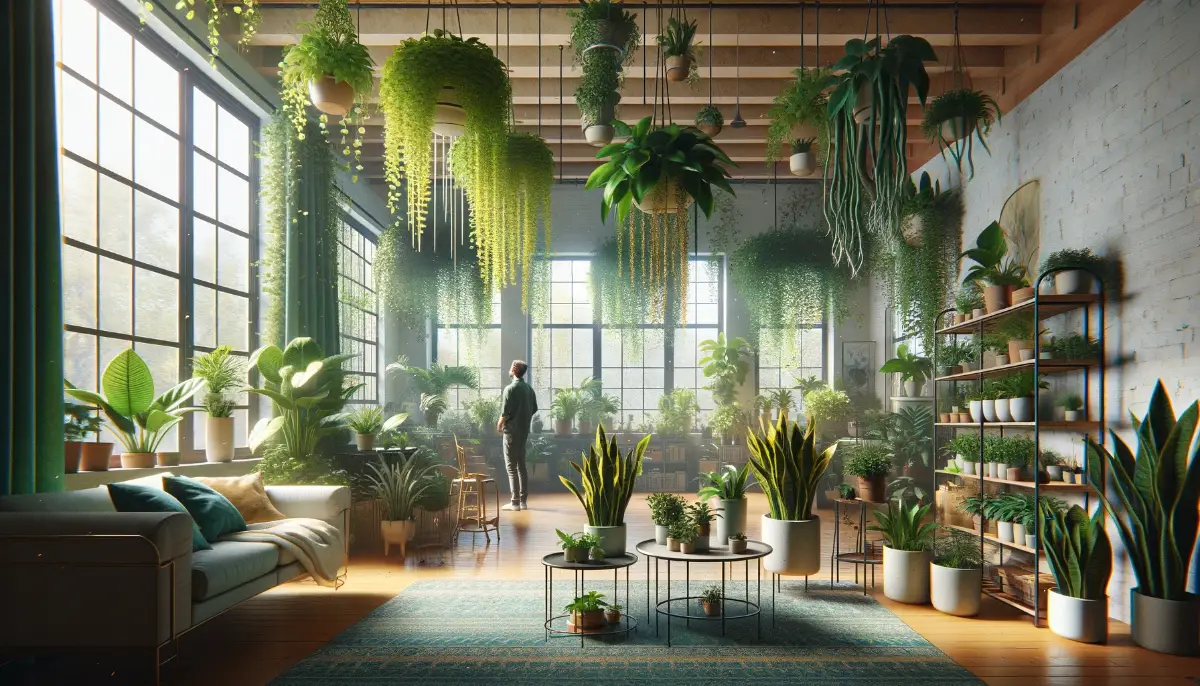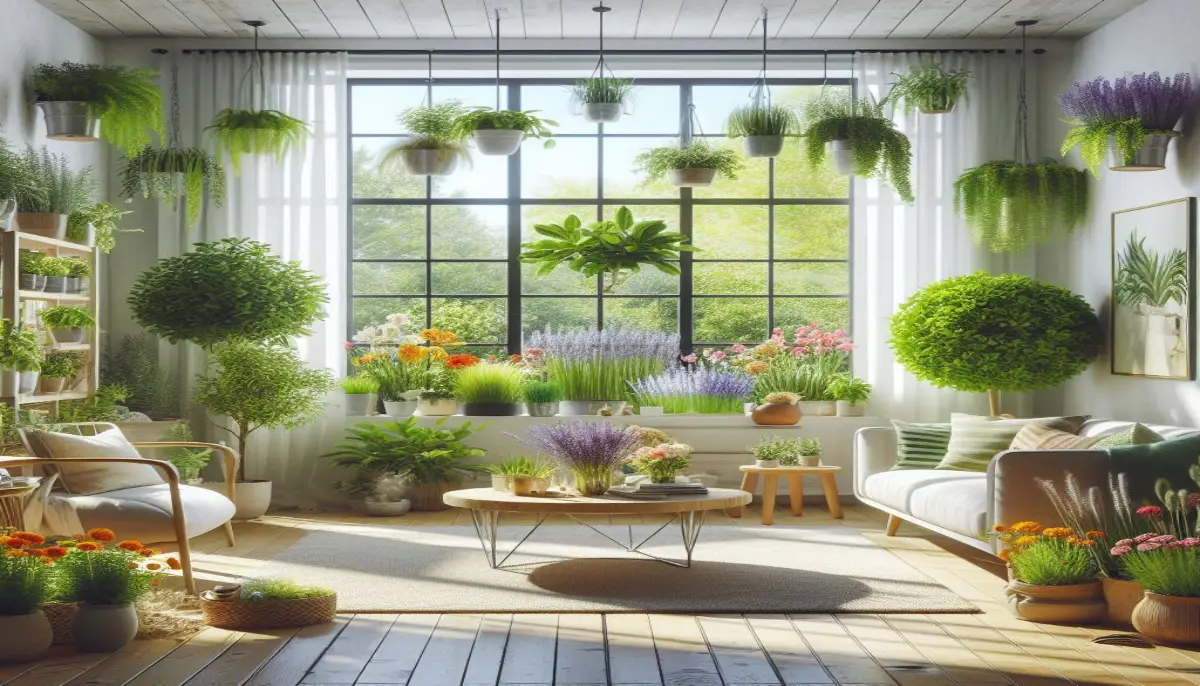In an era where indoor air quality is a growing concern, incorporating air-purifying plants into our homes has become a popular and effective way to enhance our living spaces. Not only do these plants bring a touch of nature indoors, but they also play a crucial role in cleansing the air of toxins.
Among the multitude of options, certain plants stand out for their exceptional air-purifying capabilities. Let’s delve into the world of these green heroes and find out which indoor plant purifies the air the most.
- Peace Lilies lead the pack in air purification, effectively removing a variety of toxins.
- Bamboo Palms are pet-friendly options that tackle several common indoor pollutants.
- Dracaena Plants offer a wide range of benefits, particularly in removing benzene from the air.
Peace Lily: The Supreme Air Purifier
The Peace Lily (Spathiphyllum ‘Mauna Loa’) has been recognized for its remarkable ability to filter out harmful toxins such as trichloroethylene, xylene, ammonia, toluene, benzene, and formaldehyde. A study highlighted by NASA and various sources confirms the Peace Lily’s prowess in significantly reducing indoor air pollutants, making it an ideal choice for homes and offices alike.
Bamboo Palm: A Pet-Safe Purifier
Bamboo Palm (Chamaedorea seifritzii) emerges as a pet-friendly air-purifying champion. It’s known for its ability to remove xylene, benzene, toluene, formaldehyde, and trichloroethylene from the air. Its adaptability to small spaces and low maintenance requirements make it a favorite among apartment dwellers seeking a greener and cleaner living environment.
Dracaena: The Benzene Battler
The Dracaena family is celebrated for its air-cleansing abilities, with a particular emphasis on combating benzene. Varieties such as the red-edged Dracaena (Dracaena Marginata) are particularly effective, showcasing the potential of these plants to improve indoor air quality significantly.
Other Noteworthy Plants
- Spider Plants and English Ivy are lauded for their robust air-purifying properties, capable of tackling pollutants like formaldehyde and carbon monoxide, making them excellent choices for enhancing indoor air quality.
The Snake Plant (Sansevieria trifasciata), also known as Mother-in-Law’s Tongue, is another hardy option that excels in filtering out formaldehyde, especially useful in bedrooms and bathrooms.
Caring for Your Air-Purifying Plants
While these plants are champions at purifying the air, they do require care to thrive:
- Peace Lilies and Bamboo Palms prefer bright, indirect light and should be watered once a week.
- Dracaena plants thrive in semi-sunny to shady locations, requiring moist soil but not overwatering to avoid root rot.
- Regular misting and avoiding direct sunlight are key for English Ivy and Spider Plants to prevent spider mites and maintain health.
Integrating air-purifying plants into your home is a simple and effective way to improve indoor air quality. Whether you choose the highly effective Peace Lily, the pet-safe Bamboo Palm, or the benzene-fighting Dracaena, these plants offer a natural solution to removing harmful toxins from your environment.
By understanding the specific needs and benefits of each plant, you can create a healthier, more inviting indoor space that not only looks good but feels good too.
Incorporate these green warriors into your home and breathe easier, knowing that nature is working its magic to purify your air, one plant at a time.
FAQs on Air-Purifying Indoor Plants
How do air-purifying plants improve indoor air quality?
Air-purifying plants improve indoor air quality by absorbing pollutants like benzene, formaldehyde, and trichloroethylene through their leaves and roots. The process involves photosynthesis, where plants convert CO2 into oxygen, simultaneously removing toxins from the air and improving oxygen levels indoors.
Which indoor plant purifies the air the most?
The Peace Lily (Spathiphyllum ‘Mauna Loa’) is often cited as one of the most effective air-purifying indoor plants. It can remove a wide range of toxins, including trichloroethylene, xylene, ammonia, toluene, benzene, and formaldehyde, from the air within a short period.
Are all air-purifying plants safe for pets?
Not all air-purifying plants are safe for pets. For example, the Peace Lily and certain varieties of Dracaena are toxic to cats and dogs if ingested. However, the Bamboo Palm is a pet-friendly option that effectively purifies the air without posing a risk to your furry friends.
How many plants do I need to purify the air in my home?
The general recommendation is to have at least one air-purifying plant per 100 square feet of home space. However, the more plants you have, the more effective the air purification will be. It’s important to consider the size of the plant and the room when determining how many plants you need.
Do air-purifying plants require a lot of sunlight?
The light requirements for air-purifying plants vary by species. While most prefer bright, indirect light, some, like the Peace Lily and Dracaena, can tolerate low light conditions. It’s essential to research the specific light needs of each plant to ensure they thrive and continue to purify the air effectively.
Can air-purifying plants remove all toxins from the air?
While air-purifying plants significantly reduce levels of certain toxins, they cannot remove all pollutants from the air. They are most effective when used in conjunction with regular ventilation and air filtration systems. However, they are a natural and effective way to enhance indoor air quality.
How often should I water my air-purifying plants?
Watering requirements depend on the type of plant. Generally, most air-purifying plants like to be kept moist but not waterlogged. Overwatering can lead to root rot, so it’s crucial to allow the soil to dry out slightly between waterings. Always check the specific watering needs of each plant









